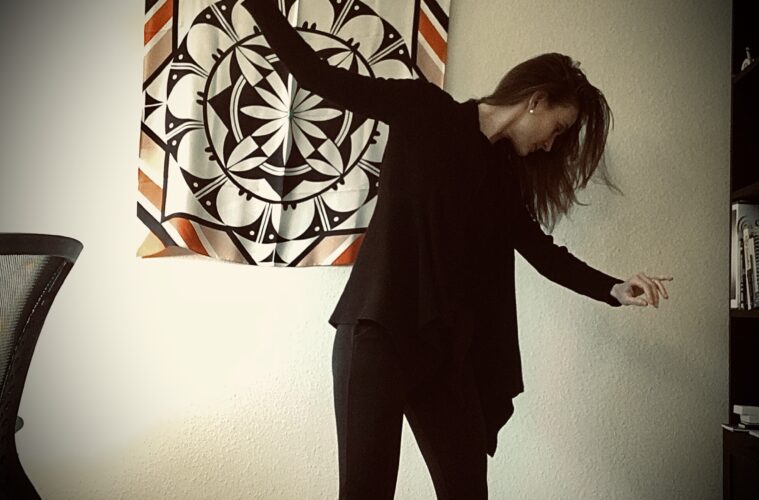Movement as a resource for reconnection during pandemic times.
Paula Ditzel Facci, a lecturer at the Unit for Peace and Conflict Studies at the University of Innsbruck, introduces her new book Dancing Conflicts and reflects on how movement can be used as a way to reconnect when in-person encounters are restricted.
Articulating resources for transformation in early 2020
Among the many events of 2020, one that made me particularly happy was the release of my latest book Dancing Conflicts, Unfolding Peaces: Movement as Method to Elicit Conflict Transformation. As I edited the final text at the beginning of that year, little did I know that impending extraordinary times would urge me to practice my ideas in yet uncharted territories.
Dancing Conflicts is the outcome of eight years of research and practice exploring how peaces and dances have been related in different cultures. It also investigates embodied ways to creatively tap the energies of conflicts for inspiring possibilities of transformation and new dynamics in relationships. The book articulates these learnings into a framework devised as an experiential exploration of one’s intrapersonal and relational movements to facilitate eliciting resources for self-knowledge, transformation and flourishing.
The pandemic hit
Dealing with the planetary and subjective impacts of the pandemic professionally and personally demands these resources all the more. Fear and anxiety generated by news about deaths, loss of health and jobs, undermined peace efforts and the depths of social injustice and the climate crisis became frequent companions. While I had the privilege of safely working from home, physical distancing and lockdowns still affected my emotional reserves for facing the challenges of these times. The pandemic reminded me bluntly that encountering people and being in the presence of family and community nourish me and my work with peace and transformation. Not experiencing it in person was undermining my abilities to be present and resonant in being of service.
Nuances of saudade
Saudade is a Portuguese word that describes the feeling of missing someone. It is often accompanied by melancholy but can also have a tint of cheerfulness. Saudade implies having kind memories and a willingness to be close to someone again. As a person who has lived in multiple places, I have been familiar with saudade throughout my life. I thought I had developed quite a resilient relationship with it. As Brazilian musician Luiz Gonzaga (Gonzaga and Teixeira 1989) sang, saudade can remind oneself how happy one has been.
However, having no perspective of meeting family and communities in person any time soon due to travel restrictions evoked the flip side of saudade more acutely, the one that is bitter and dragging. Energy levels dropped, my back hurt and I found myself grumpy and defensive, with a waning grit for engaging in transformation. These signs sounded the alarm of imbalance, a reminder to fall back into my regular dance and meditation practice. As motivation and focus began to oscillate, I found another possibility of nourishment in dance: to explore different forms of connection.
Finding resonance through distance with movement
In the room-turned-office-turned-dance floor, I am reminded, again and again, that I am welcome, in whatever mood I am, in whatever space available – even in the two square meters in between the desk and the bookshelf. This space seems to amplify whenever I am present in my body and breath, echoing the amplitude I find inside. Concomitantly, I sometimes feel curbed by the curtailed threads congested in that inner space, cutting myself off from my environment, creating barriers, constraining my movements and my freedom.
Dancing has offered me a resource for getting in contact with what is, witnessing and moving with the struggles in myself and the world. The pervasiveness of each breath bestows the opportunity to patiently untangle those threads. Moving, I can be with frustration and sadness, and get glimpses into possibilities of reawakening connection to my loved ones through body, heart, consciousness, air, earth. Each step offers a means to interweave the untangled threads with loving-kindness, restoring a fabric that expands through space and time. Resonating through distance with family and friends evokes the feeling of being part of the vibrant interconnected web of life, which nourishes me to facilitate spaces for others in peace and conflict work.
“Saudade, meu remédio é cantar”, sang Luiz Gonzaga (Gonzaga and Teixeira 1989) to alleviate his pain. My medicine to saudade is dancing, where I keep rediscovering old new ways to connect near and far and to rekindle my perseverance for transformation.
May each fall
Gonzaga, Luiz, and Humberto Teixeira. 1989. “Qui nem jiló” in O Melhor de Luiz Gonzaga.
Be an invitation
To fall in love
All over again
With ourselves,
With life.
An invitation
To fall back
Into the love ne(s)t
That connects all.
RCD. Sony Music, BMG-Ariola.


